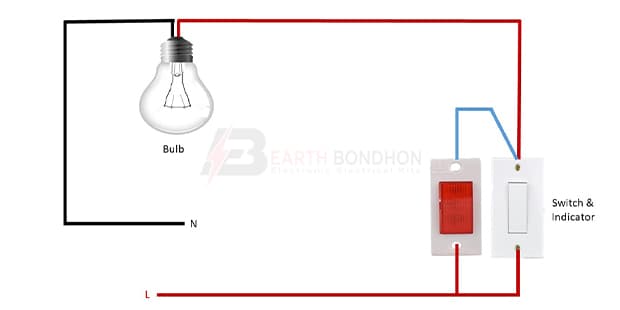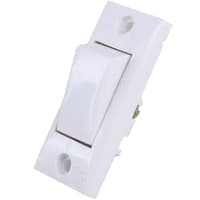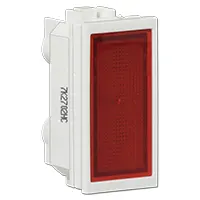On Off Switch with Indicator Light wiring:
This diagram shows how to make an On-Off Switch with Indicator Light wiring. In this circuit, we use a light, a switch, and an indicator light. First, we need to input the phase line to the switch and indicator light. Then input phase to light from the switch and input the neutral line to light. Now our circuit is ready for use. If you want to know more about this circuit please check our youtube video below the post.
Advertisements
Components needed For this Project:
You can get the components from any of the sites below:
- SPST Switch [See Buy Click Amazon]
- Board Indicator [See Buy Click Amazon]
- CFL Light [See Buy Click Amazon]
*Please note: These are affiliate links. I may make a commission if you buy the components through these links. I would appreciate your support in this way!
Advertisements
Components used to make the On Off Switch with Indicator Light wiring:
An SPST (Single Pole Single Throw) Switch is a Switch That only Has a Single Input and can Connect Only to one Output. This means it Only Has one Input Terminal and Only 1 Output Terminal. A Switch is a Mechanical or Controlling Device That Changes the Flow of Current Direction or Interrupts the Flow of Current Within a Circuit diagram. An electrical line using Single Pole Single Throws (SPST) is Perfect for on-off switching. When the SPST is closed, the Circuit is Closed and the light from the lamp switches on the system. When The Single Pole Single Throw (SPST) is then opened, the light from the lamp goes out and the Circuit is off.
02. Indicator:
Board indicators are optoelectronic devices that emit light to show the operating condition of a machine or appliance. Manufacturers and distributors use various terminologies for this type of product which can be confusing when trying to power source an item, particularly on-line: Signal lamps. Signal lights. That is an example of an indicator light bulb.
CFL stands for Compact Fluorescent Lamp which is an improved version of tube lights of earlier days. Like tube lights, it is a vacuum glass tube with fluorescent powder coating which is not as long and straight as tube lights but curved/twisted compact, or small in size. Like a tube light, it has electrodes or filaments at both ends. But in this case, instead of a choke, there is an electronic circuit that drives the Compact Fluorescent Lamp. Because the red wave is less in the light of the Tubelight and Compact Fluorescent Lamp, the object looks a little pale or the correct color of the object does not appear.
Thank You for visiting the website. Keep visiting for more Updates.
Frequently asked questions
When the indicator is turned on current flows through the power supply heater coil, through the made contacts, and lights the indicator lamps on the vehicle - at the same time, as warming up the bimetallic strip which bends when heated and opens the Circuit diagram switch contacts, turning off the lights and the heater coil.
Canceling the power supply Signal After completing your turn or lane change, be sure to turn off your indicator. Most cars will automatically turn off the signal after the turn is completed, but if it doesn't, simply push the lever in the opposite direction to deactivate it.
Off Indicator, An illuminated off indication means the Projec system associated signal is showing a proceed aspect. These are mainly used at stations, for the benefit of the train crew and platform staff. When the display is blank, it means that the associated signal is in danger.
In most cars, the turn signal lever is located to the left of the steering wheel. Shifting the current lever up indicates a right turn and shifting it down indicates a left turn. Your turn signal should turn off after a turn or a lane change, but if it does not, you should turn it off and on manually, as soon as possible.
You will often see circuit diagrams carrying less than 20 amps switched directly, while circuits of 30-40 amps can sometimes be directly switched but will often be controlled by relays. Anything above 40 amps is pretty much always off and on a relay.
Read more Single Phase Wiring
What is a kilowatt-hour (kWh) | kwh formula | What does kwh mean
Introduction to Electrical Units and CircuitskW and kWh on your electricity bill As your home uses electricity during...
What is the Difference Between kVA | What does KVA mean | kVA formula
Difference Between KVA ExplainedWhat does KVA Mean? There are technical terms aplenty when it comes to generators, and...
Power Factor | Power Unit | Energy | Electricity Unit
Power factor definition | Calculating Power FactorPower Factor Values In a purely resistive circuit, the power factor...




0 Comments